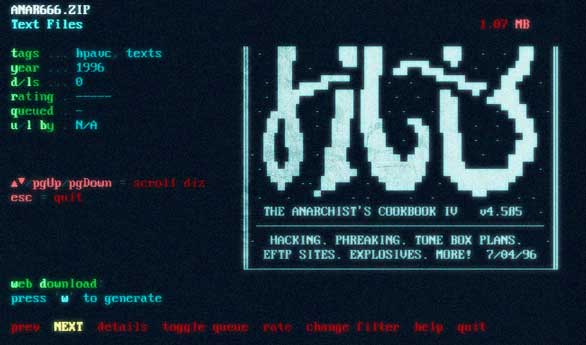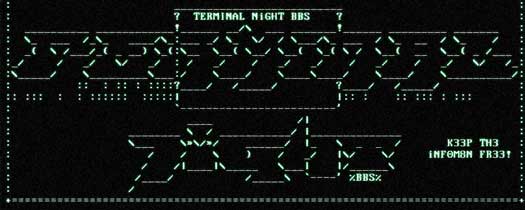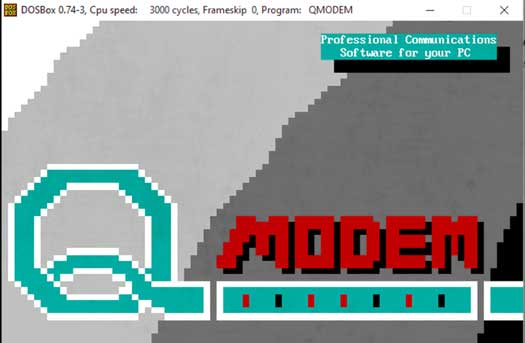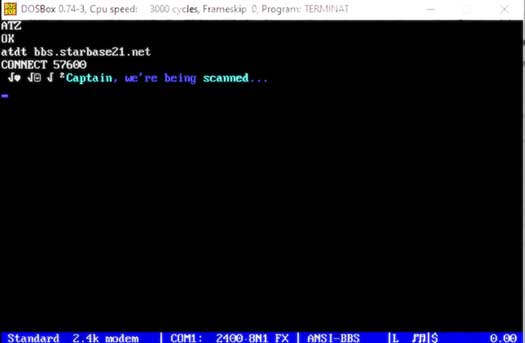
Where are all the BBS T3XTFiL3Z at?
Terror in the Bulleting Board System
I don’t know if it’s always been there and I simply never noticed, but nostalgia for BBSs seems to be on the rise. Those creaky old pre-internet treasure troves of shareware, ASCII art and early online games never actually died. They just went further underground as the internet took center stage.
When I was a kid in the 90s, I spent my evenings logging onto BBSs for a brief period before the internet barreled onto the scene. During that time, I played online text-based door games like Tradewars 2002 and read message board echos. But what BBBs were most about for me was the file areas. Sure, there were games, cracks and warez, but it was the text files I was usually after. BBSs of the time, or at least the more underground ones, tended to contain hundreds of text files covering all manner of arcana and forbidden knowledge. From files on hacking and phreaking to the infamous Anarchist’s Cookbook. All of it served without ads. An entire library of forbidden knowledge! Or at least that’s how it seemed to a kid.

When I got the idea of writing a story about a psychedelic trip that veers cosmic horror territory (think Beyond the Black Rainbow if it was directed by Gregg Araki), I went looking around for a plausible means by which a bunch of psychonaut-curious teenagers might get their hands on a cosmic horror psychedelic cocktail. A discarded file on the darknet, an old message in an internet newsgroup, a spooky website. All of these things could work but they felt overdone. That’s when my mind turned back to those early BBS days.
Compared even to the early internet, BBSs had always been niche, and finding files of dubious legality was par for the course. Moreover, BBSs belonged to a time when being online was new and, at least in those early days, felt more trustworthy. Unlike the anonymous internet, logging onto a BBS meant you were dialing into a real person’s computer. Someone in your city was hosting you on their network and sharing their files with you. Most of the time, they seemed to be run by freaks and other counter-culture types. Though, for all I knew, it was just other kids playing at being cyberpunk. Nevertheless, as a kid the process of dialing into someone’s computer and typing my way into obscure text-based boards felt like I was sneaking into a secret society and getting a peak at a cultural underground that I was too young to be a part of. It was awesome!
Wasted Youth 1995
As soon as I got the idea of setting the story in those last days of the BBS scene, I took a bit of a dive into the music and culture of the era. I re-watched Hackers (yes, it’s terribly innacurate) and made a playlist of 90s music that my characters might have plausibly listened to. Skinny Puppy, Nine Inch Nails, KMFDM, The Cure, The Prodigy…
However, as I started writing, I realized that I just did not remember enough about BBS culture and lingo to do it justice. For example, I knew that I wanted the title of the story to be the name of a BBS and reflect authentic BBS names of that era, but I only had a vague sense of what those names were like. I had the recollection that a lot of BBSs tended to have names that where either a bit cyberpunk, a bit anarchist or instead were like something out of a D&D. Fortunately, I stumbled across a treasure trove of 90s era textfiles, including BBS lists organized by area code at the aptly named website textfiles.com.
From there, I found boards with names like: Parity Error BBS, Eternal Illusions BBS, Hell on a Disk, Psycho-Shoppe, CyberDeath BBS, The CyberPit, Night Stalker, Terminal Insanity, etc. And thus, by combining a few tropes, TERMiNAL NiGHT BBS was born!

BBS Archeology
As I mentioned at the beginning of this post, BBSs are still going strong, and as I read more about the BBS scene of the 90s, I inevitable came across the BBS scene of today. It was amazing to see how the idiom had survived the drastic changes in the ways people connect online. Modern day BBSs are still largely composed of ASCII graphics and text, door games, message boards and file areas. Some of them run on modern hardware (or even little Raspberry PIs), others use various tricks to fool vintage PCs into thinking they’re making a modem connection when in fact all communication now goes through the internet (i.e., telnet). I found that there was something poetic in how the internet had –almost overnight– made BBSs obsolete and rather than die out, they co-opted the internet as a communication protocol and kept on keeping on!
As the writing progressed, I got the idea of including screen caps of the fictional BBS the story’s characters would be logging into. However, to get it right and have it be authentic, I needed to see what BBSs of the era look and felt like. The best way to do that, I figured, was to find a modern day BBS that still ran the old BBS host software that I used to log into. Amazingly, among the lists of BBSs at textfiles.com I found one for my old area code. One piece of info this list contained was the specific type of BBS hosting software that a given a board was using. Turned out in my area code in the mid-90s, most BBSs that were still active were using a BBS software called Maximus. In the modern-day BBS scene, Maximus does not seem to be at all popular (e.g., Modern Day BBS list). But there are still a few scattered BBSs running Maximus, and all I needed was to get a feel for the menu system take some screen caps so I could recreate it.
Armed with a few telnet addresses, the next piece of the puzzle was to figure out how to use a 90s era BBS client or terminal programs. There are, of course, modern terminal programs that allow one to connect to the BBSs of today, but whether for nostalgia or some strange obssesion with authenticity, I really wanted to use the same one I did as a kid. However, I wasn’t entirely certain what the hell I was using back in the day. After scrolling through a few 1990s BBS articles in the archive of PCMag on Google Books, I recognized the names QMODEM and TERMINATE as terminal programs that I must have been using. Strangely, I couldn’t find any screenshots of their interface or menu system on Google image. It seems no one felt that that piece of technological history was worth salvaging. Bloody philistines!
The sound of dial-up
During all of this “research”, I listened to a lot of dial-up modem handshake/connection sounds. And I mean a lot. I grew to recognize the different baud rates and communication protocols by sound. There is horror and dread in those strange tones, and I was hoping to mine that for the story. Oddly, I was unable to find the sound of the modem I had when I was kid among these recordings. Most of what I was finding was of 14.4kbps modems and above, all the way to the ubiquitous 56kbps of early internet days. That, however, was not the sound of my first dial-up experiences.
Although I didn’t know it at the time, my family had an ancient modem, even for that era. So when everyone else was on 14.4kbps or even 56kbps, I was, it seems, still rocking an old 2400baud. And that is the handshake sound that is buried in my brain. Oddly, the 2400baud dial-up sound appears to be another casualty of history. Youtube is full of 56kbps videos and spectrograms, but 2400baud modem sounds are strangely absent. I was about to give up, when I landed on the archived sound of modems back pages of an amazing Australian tech blog
techzone where the author obsessively detailed the different types of modem connection types and recorded audio files at all the major baud rates –now that’s my kind of crazy! Buried on the website were a few MP3s of a 2400 baud connection recorded on various hardware modems. One file in particular contained exactly the sound I remembered!
credit for the mp3 recording to techzone
Hopefully readers of the story, or at least those with some modem experience, will recognize that the sound described in the story is something far older and more ominous than the comparatively dulcet tones of the 56kbps modems… Do these details even matter? Probably not… But if just one other person is like, “oh shit, that’s a 2400baud handshake! Niiiiice” then it will have been worth it.
Update: Ten days after I wrote this post, someone uploaded a video of all the modem handshake sounds from 300baud to 56kbps.
Emulating vintage BBS software with DOSBOX
As I mentioned above, the final piece of the puzzle was logging into a BBS using a vintage BBS client from the 90s to see how it would have looked and operated back in the day. With some trepidation at how many hours this might cost me, I entered into google “How to use QMODEM in dosbox”. Although I’d never used it before, I was aware of DOSBOX as a way of running old MS-DOS era abandoneware games and programs on modern windows machines. I was pretty sure most MS-DOS programs would work in DOSBOX but what I was less sure of is if you could trick a 90s era BBS client –assuming you could find a copy– into believing it was making a modem connection to a modern BBS all without ever using a phoneline.

Fortunately, it wasn’t all that difficult. I found an excellent tutorial that described how to do just that starbase21 telemate tutorial. Although the tutorial describes the process with a different client (Telemate), it seemed straightforward to adapt the instructions to QMODEM or TERMINATE. So let’s give it a shot.
Mini tutorial on using DOSBOX to run a vintage BBS client
- Download and install DOSBOX
- Create a
dosdirectory under your C: drive. - Edit the config file for dosbox typically found under:
C:\Users\<yourname>\AppData\Local\DOSBoxand follow the instructions in the link posted above which basically involve changingserial1=modem listenport 23and disabling serial2. - Download qmodem. Qmodem is officially abandonware as the company that owns the rights -as well as the company that bought that company- want nothing to do with it. When someone wrote them inquiring about purchasing a copy, they apparently told the person to go find a crack on the internet. _Note: After playing around with Qmodem, I realized it doesn’t allow you to send ATDT commands directly to the modem and really only seems to support phone numbers.
- Instead, I opted to use TERMINATE. (found a copy here: terminate500)
- Fire up dosbox!
- Just installing this little 1.4MB program took a while in the dosbox instance.
- One I got it up and running, I issued command
atdt bbs.starbase21.netas in the tutorial above and… it works! I have it set to run at 2400 baud so it’s slow as molasses but it was necessary to simulate the experience.

